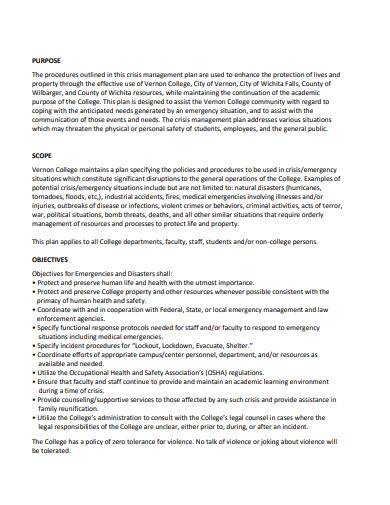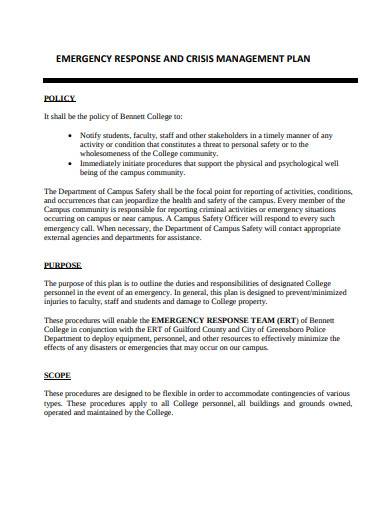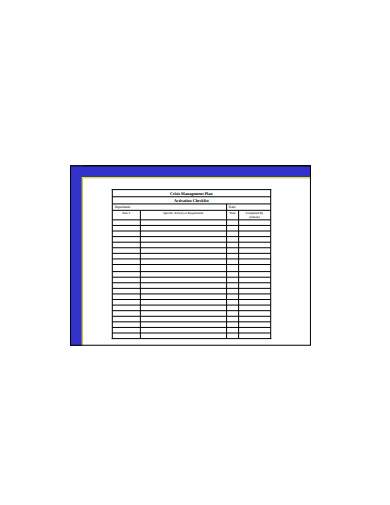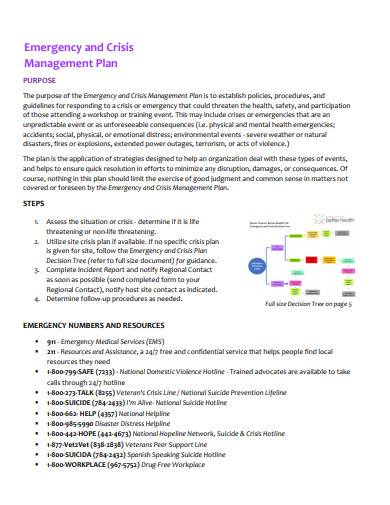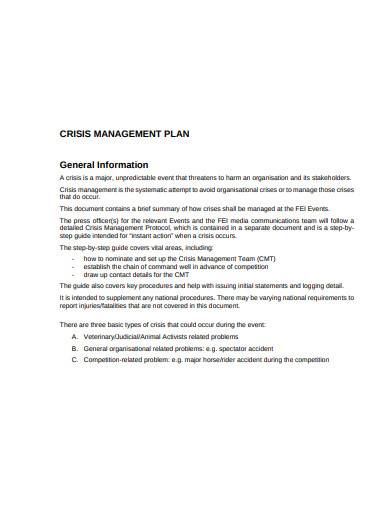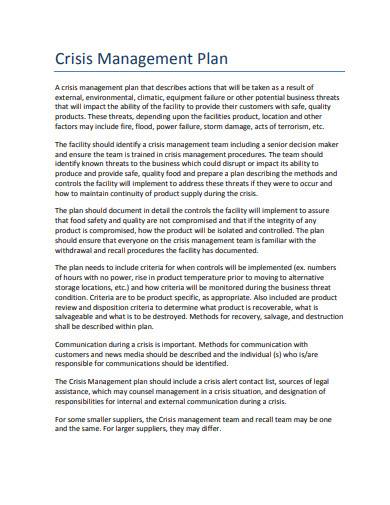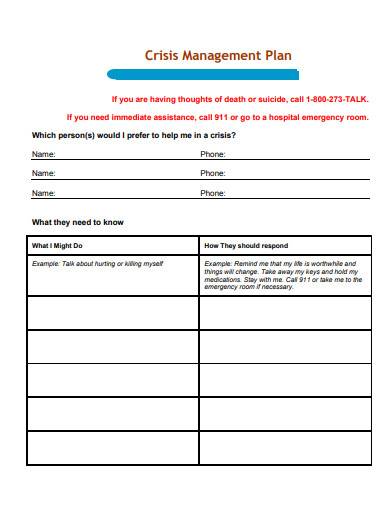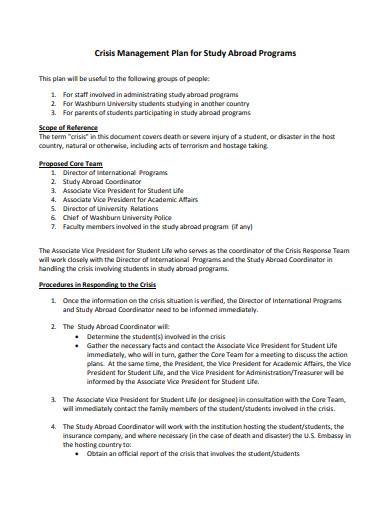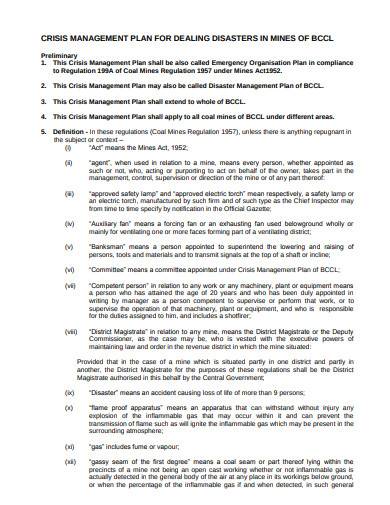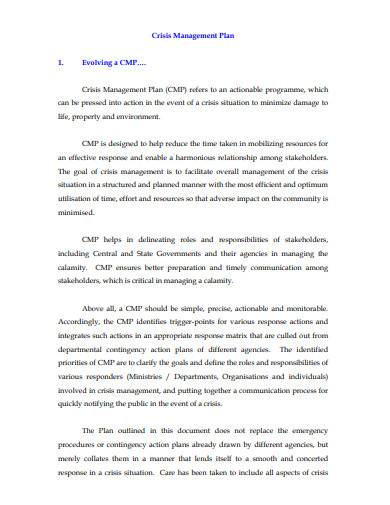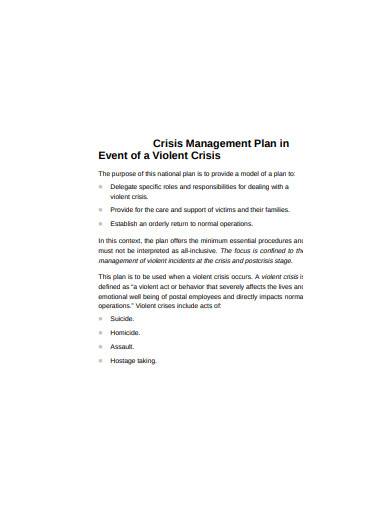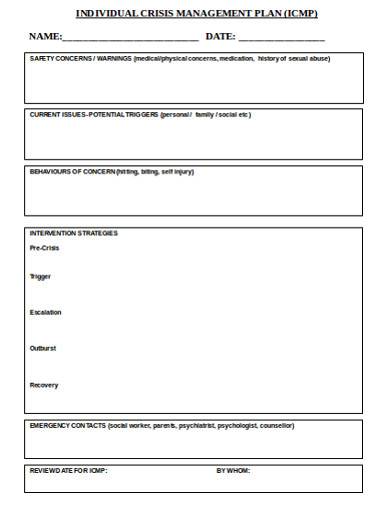No man, beast, or business is ever truly safe. As a matter of fact, the world during 2020 is facing a major crisis brought by the COVID-19 pandemic. And if the situation goes any longer, it might extinguish a man, a beast, and a business in a snap. As such, your business should withstand the challenges caused by a catastrophe—from natural disasters to the stock market crash. And the key to do so lies in your ability to contain and manage crises. Although crisis management can be a daunting task, it is not right to deny your company of a crisis management plan that would save it from the onslaught of a catastrophe.
13+ Crisis Management Plan Samples
1. Crisis Management Plan Sample
2. Corporate Crisis Management Plan Template
3. Crisis Management Plan Checklist Sample
4. Emergency and Crisis Management Plan Template
5. School Crisis Management Plan
6. Basic Crisis Management Plan Template
7. Crisis Management Plan in PDF
8. Standard Crisis Management Plan Sample
9. Formal Crisis Management Template
10. Crisis Management Plan Program Template
11. Crisis Management Plan for Dealing Disasters
12. Printable Crisis Management Plan in PDF
13. Crisis Management Plan in Event Sample
14. Individual Crisis Management Plan in DOC
What Is a Crisis Management Plan?
A crisis management plan is a document written by the crisis management team, which outlines how organizations like businesses and schools respond to critical situations that would interrupt normal operations. Part of the crisis planning procedure is clearing out what a crisis is. Moreover, a crisis response plan should specify the ways to prevent the catastrophe (if possible), what to do during its occurrence, and how to maintain operations post-cataclysm. Serving as both safety prevention measures and contingency plans, what crisis management brings to your company is the power to push on despite unexpected occurrences.
Business Insider reports that over 2 million workers in the United States might lose their job due to the coronavirus pandemic. The foundation of this forecast is the fact that more than 90% of firms in the country are small businesses, which means that cash-strapped enterprises couldn’t bear a month-long interruption. A crisis is unpredictable, and we will never know when it will affect us. But preparedness and adherence to the crisis management protocol will help save an organization from crumbling.
How Do You Write a Crisis Management Plan?
A well-prepared crisis management strategy can pull your business through the toughest of times. That is why companies and other organizations must have a crisis and emergency management plan. To help you with that, here are a few tips and tricks you can use to write a crisis management plan.
1. Identify the Threat
Risk assessment plays a vital role in a crisis management plan, as this helps you identify threats. You can never plan effectively for something you have no idea about. As such, run a data analysis and risk assessment to gather as much intel as you possibly can before proceeding to other parts of the plan
2. Use Preventive Measures
As health experts say, “An apple a day keeps the doctor away.” Despite this being a common saying, the message is clear; the first part to crisis management is prevention. If the threats to your business are preventable, then it’s best to start your plan off with preventive measures to keep incidents from happening in the first place.
3. Ready an Action Plan in Case of Occurrence
While you can prevent some disasters, others occur without warning and hit hard and fast. For natural disasters, robberies, and others of this nature, it is imperative to have a strategic action plan. Having a strategy aimed at keeping your staff and assets secure in case of disasters or security breaches assists significantly in maintaining people level-headed in a panic-inducing situation.
4. Have Post-Crisis Operation Procedures
A crisis management plan aims to establish order and maintain operations despite a calamity. As such, an integral part of your management plan is the procedures you implement post-crisis. Having this system set up allows you to keep your company alive and productive come what any and most situations.
FAQ’s
What is the purpose of a crisis management plan?
We would never know how to deal with a crisis if we don’t prepare for it. That is why it is always crucial for businesses to devise a crisis management plan to prevent or reduce loss during a critical situation that affects the company as a whole. Aside from that, this document also helps a business bounce back and manage the effects of the crisis.
What are the components of a crisis management plan?
When you take a look at a crisis communication plan template or an emergency preparedness communication plan template, you will see that it contains several elements. A crisis management plan includes a series of scenarios, plan objectives, procedures to follow, designated chain of command, communication channels, and backup resources.
What are the three phases of crisis management?
The crisis management process involves three phases, namely pre-crisis, crisis response, and post-crisis.
Whether it’s a natural, a man-made, or an entrepreneurial catastrophe, a disaster can strike without rhyme or reason. However, the most successful businesses manage crises and keep steady operations regardless of the eventualities. Crisis management then becomes an integral aspect of corporate survival as it helps you prevent the hazards that you can, prepare for the ones you can’t, and maintain an iron-clad fist on your stocks despite the chaos around you.
Related Posts
FREE 9+ 30-Day Marketing Plan Samples in PDF | MS Word | Apple Pages | Google Docs
FREE 3+ Sales Team Action Plan Samples in PDF | MS Word | Apple Pages | Google Docs
Marketing Plan For Small Business Samples
FREE 7+ Fashion Business Plan Samples in PDF
FREE 10+ Sprint Planning Samples In MS Word | Google Docs | PDF
FREE 10+ Wedding Planning Samples in MS Word | Apple Pages | Powerpoint | PDF
FREE 9+ Monthly Study Planner Samples in PSD | Illustrator | InDesign | PDF
FREE 9+ Sample Curriculum Planning Templates in PDF | MS Word
FREE 10+ Teacher Development Plan Samples in MS Word | Google Docs | Apple Pages | PDF
FREE 10+ Basketball Practice Plan Samples in PDF
FREE 12+ School Business Plan Samples in PDF | MS Word | Apple Pages | Google Docs
FREE 7+ Client Strategic Plan Samples in PDF | MS Word
FREE 11+ Trucking Business Plan Templates in PDF | MS Word | Google Docs | Pages
FREE 7+ Small Hotel Business Plan Samples PDF | MS Word | Apple Pages | Google Docs
FREE 14+ Bakery Business Plans in MS Word | PDF | Google Docs | Pages

